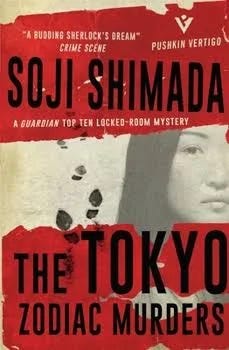Review: The Tokyo Zodiac Murders - Soji Shimada (1981)
Summary: It’s 1936 in Tokyo and three horrible murders have occurred. The first is the murder of an eccentric artist whose body was found behind the locked door of his studio which he rarely leaves. A letter penned by him was found describing how his six of his daughters, living in the same compound, should be killed to form the perfect woman. The second was the murder of his eldest daughter, living by herself post divorce in a remote Japanese village. The third is the murders of his six other daughters whose bodies were later discovered with body parts missing according to their father’s instructions.
It’s been 40 years and no one has solved The Tokyo Zodiac Murders. Countless people have come up with countless theories and even the police have not found a plausible explanation. An astrologer and his illustrator friend receive new evidence and set off to solve the murders - in one week!
Genre: Detective Fiction, Murder Mystery, Japanese Mysteries, Locked Room Murder
Rating: 5/5
They say the devil is in the details. And when the book’s author challenges you to solve the murder with the clues provided in the story, there is no excuse for not following the details closely. I couldn’t read this book fast enough because as our investigators race against time, I felt their stress, anxiety and helplessness.
In my defense, I did guess who the murderer might be but I wasn’t sure how this locked door murder was committed.
I love Japanese murder mysteries. (Also check out The Mill House Murders.) It’s probably because they are unique, the tone is different and we get a glimpse into Japanese culture and conversation.
The book consists of five acts including letters from the author in between, reminding us that we should be able to solve the case considering all the clues have been provided. I did feel a bit frustrated. It feels like a play is being enacted in front of us and I was a passive participant in the investigation.
The first part of the book in which the murders are described is disturbing. You have to brace yourself. You’re imagining the dismembered bodies of the young women and it’s not pleasant and this distracts us from the clues. There’s a lot of astrological details which again overwhelm us but not in a bad way - I took it as a challenge to follow and make mental notes of everything.
In the third act, we get to explore a bit of Japan, especially Kyoto, and this is really nice. It sweetens the grotesque vibe we’ve got so far. It ends with our astrologer having a eureka moment but I was left feeling a little put off. I had my suspicions but no explanation to support them.
The fourth act is when the investigation heats up and as usual, time is running out. However, our astrologer (the lead investigator) solves the case.
The fifth act is the big reveal and it’s a lengthy explanation but well worth it.
I don’t think I’ve been this gripped by a murder mystery recently. There so are many red herrings and the important necessary clues have been cleverly concealed. Hiding in plain sight as Sherlock Holmes would say. Please note that I’m giving you tips should you read the book.
I totally understand why The Guardian ranked this book as #2 on its list of locked room mysteries.
Interestingly, there are quite a few mentions of Sherlock Holmes and his style of deduction in this book. Our detective here mocks Holmes but is very much like him - has depressive episodes, is a difficult person to understand and be around but is very intelligent with a keen sense of understanding people (because he’s an astrologer I suppose). His partner in this story resembles Watson - eager to prove that he is smart and capable of finding the answers while being at the beck and call of the main detective. I think the cherry on top is when our sidekick wants to write a book about solving the case. Watson much?



